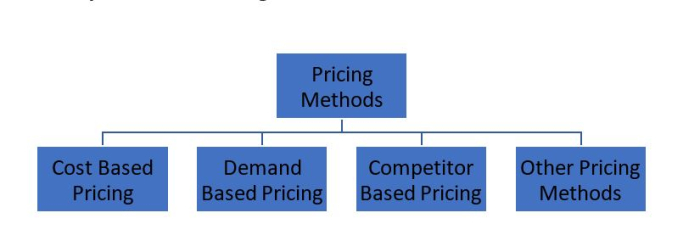
 Data Structure
Data Structure Networking
Networking RDBMS
RDBMS Operating System
Operating System Java
Java MS Excel
MS Excel iOS
iOS HTML
HTML CSS
CSS Android
Android Python
Python C Programming
C Programming C++
C++ C#
C# MongoDB
MongoDB MySQL
MySQL Javascript
Javascript PHP
PHP
- Selected Reading
- UPSC IAS Exams Notes
- Developer's Best Practices
- Questions and Answers
- Effective Resume Writing
- HR Interview Questions
- Computer Glossary
- Who is Who
The concept of Pay at Will
The 4 Ps (product, price, place, and promotion) of marketing dictate the behavior of every producer in the market. These four factors help the producer decide the basic layout of the business.
What do they want to produce?
Where do they want to sell the product?
What price do they want to charge for the product?
How do they want to advertise the product?
It is time that we take a deeper look at the concept of pricing the product. The pricing factor is of utmost importance for the business because this is the only branch that brings in revenue for the company; all the other three branches are cost-bearing activities for the firm. In this article, we will be diving deep into the various methods of pricing the product and the trending concept of paying what you want for the product or service.
Concept of Product Pricing
Producers can determine the price of the product in various ways. Some of the ways are

Cost-based Pricing
Using this method, businesses can determine the price of a product based on its cost. It is generally seen in retail industries. There are two ways in which companies can determine the price ?
Cost-plus pricing ? Here the producer is adding a fixed percentage to the cost of the product, and hence we can determine the selling price of the product.
Markup pricing ? Here the producer is adding a fixed percentage of the product's cost to determine the product's price.
Demand-based Pricing
In this pricing strategy, producers determine the price of the product on the basis of market demand for the product. If the demand for the product is high, producers will set a high price for the product to gain super-normal profits, and vice versa. We can see this type of pricing in the hospitality and travel industries. The success of this method totally depends upon the ability of the producer to read demand.
Competitor-based Pricing
In this method, companies set the price of the product according to the price of the competitor. It could be less or more than the competitor's pricing, depending on where the company wants to place itself. It is simple and saves a lot of money for the company, as they do not have to invest time in complicated calculations.
Other pricing Methods
Some of the other methods through which producers can set up the price of the product are
Value pricing ? producers set lower prices for high-quality products to win over the customer base.
Target return pricing ? producers want to deliver to their stakeholders a desired amount for return, and irrespective of the market, they charge prices on the basis of the target return amount.
Pay what you want ? In this case, consumers are free to pay whatever price they want for a specific product, while producers are free to showcase the same product in varying quality.
The Concept of Pay What You Want

In this method, the buyer can set the price of the product as per the intensity of their desire to consume it. In simple terms, it means the buyer can pay what they want for the product. Sometimes the buyer can even value the goods at zero rupees. For general reference, the sellers set the minimum price range for the product. In this method, consumers can pay the price of the product ?
Ex-ante ? Consumers have to pay the price before they consume the product.
Ex-post ? The consumers pay the price of the product after they have consumed it.
If we have to divide it into points ?
Consumers decide the price of the product.
Consumers can pay the price before or after they have consumed the product. (at the discretion of the seller)
Sellers can set the minimum price range.
Examples of a "Pay What You Want" pricing strategy in today's world
In-driver application ? This application assists customers in booking cabs to travel from one location to another. It is an Indian-based company. The application's pricing method will let the consumers know the minimum price for their travel route, and now the drivers will bid different amounts for the service. Consumers can accept the fare they want or wait for the other bids.
Grocery markets worldwide - All of us know that a grocery store will have the same product with different qualities. For example, you can get apples for Rs 100 per kg, Rs 200 per kg, or Rs 300 per kg. It totally depends on the consumer and how much they are willing to pay for the product. The quality and taste of apples will undoubtedly improve as the price rises.
Tips given in restaurants ? Generally, social convention dictates that the consumer leave a tip of 10% of the bill, but it is not a mandate. The consumer can tip the server as per their experience in the restaurant.


Benefits of the Pay-at-Will Pricing Strategy
Companies can easily do price discrimination ? As long as consumers value the services, they will be willing to pay more for the product in comparison to other buyers. Companies can make normal and supernormal profits using the same strategy and product or service with the least amount of effort.
Consumers will never be dissatisfied with the price they paid ? Since they can pay the price after they have consumed the product or, in some cases, after they have seen the product. Consumers will be satisfied. as they can get value for their money. This method also creates customer satisfaction because it is a buyer-centric approach. The company places a lot of confidence and trust in the consumer. This fosters a sense of belonging and emotional trust.
Companies will save a lot of time and money invested in determining the correct price ? It takes a lot of time, energy, and effort for the companies to come up with the price of the product. They have to take into account myriad factors like demand in the market, competitor pricing, the quality of the product, the cost price of the product, the status of the economy, geo-political conditions, and others. With pay at will, customers can pay based on their experience and desire for the product; as a result, the company can use this time to develop high-quality products.
Companies can demonstrate confidence ? The pay-what-you-want model's foundation principle shows the company's confidence in its own product and service. They fully believe that the experience they have provided to the consumer is of high quality, and the consumer will be appreciative of the same. It helps the company go beyond the set standards.
Pay at will is another trending concept of pricing that is coming into existence. The company shows the utmost trust in its products and customers. Customers are mostly happy because they believe they are paying for the worth of the product, and companies are happy because they can save costs and ensure loyal customers for their products and services. It is time restaurants, coffee shops, and the clothing industry started using this pricing model.

